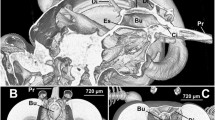Abstract
The tsetse adult extricates itself from the puparium and surrounding substrate by a series of muscular contractions that generate a Stereotypic pattern of changes in hemolymph pressure. The digging action of the fly can be distinguished from a second pattern of hemocoelic pulsations that is used to remove obstacles from its path. When the fly is restrained extrication behavior will persist for over 10 h. If the adult's legs are freed while the remainder of the body remains encased in the puparium, the fly fails to engage in extrication behavior, a result which suggests that freedom of the legs switches off extrication behavior and permits the onset of expansion of the body to its final adult size and shape. Expansion behavior includes walking, grooming, pumping air into the gut, and contracting the abdominal muscles to generate rhythmic pulses of hemocoelic pressure. A barographic record of internal pressure changes reflects the dynamics of this morphogenetic process. Results from tsetse are compared with previous observations recorded in flesh flies.
Similar content being viewed by others
References
Buxton, P. A. (1955).The Natural History of Tsetse Flies, H. K. Lewis, London.
Cottrell. C. B. (1962a). General observations on the imaginai ecdysis of the blowflies.Trans. R. Entomol. Soc. London 114: 317–333.
Cottrell, C. B. (1962b). The imaginal ecdysis of blowflies. The control of cuticular hardening and darkening.J. Exp. Biol. 39: 395–411.
Crossley, A. C. S. (1964). Transformation in the abdominal muscles of the blue blow-flyCalliphora erythrocephala (Meign.) during metamorphosis.J. Embryol. Exp. Morphol. 14: 95–110.
Denlinger, D. L., and Zdárek, J. (1991). Intrapuparial development in the tsetse fly,Glossina brevipalpis (Diptera, Glossinidae): Behaviour associated with pupation.Acta Entomol. Bohemoslov. 88: 353–358.
Fraenkel, G., and Hsiao, C. (1962). Hormonal and nervous control of tanning in the fly.Science 138: 27–29.
Fraenkel, G., Su, J., and Zdárek, J. (1984). Neuromuscular and hormonal control of post-eclosion processes in flies.Arch. Insect Biochem. Physiol. 1: 345–366.
Laing, J. (1935). On the ptilinum of the blow-fly(Calliphora erythrocephala).Q. J. Microsc. Sci. 77: 497–521.
Madubunyi, L. C. (1990). Ecology ofGlossina species inhabiting peridomestic agroecosystems in Žďárek and Denlinger relation to options for tsetse control. InSterile Insect Technique for Tsetse Control and Eradication, International Atomic Energy Agency, Vienna, pp. 309–317.
Miyan, J. A. (1989). The thoracic mechanism for eclosion and digging during the extrication behaviour of Diptera.Physiol. Entomol. 14: 309–317.
Reid, S. N. M., Fraenkel, G., and Friedman, S. (1987a). Extrication, the primary event in eclosion, and its relationship to digging, pumping and tanning inSarcophaga bullata.J. Insect Physiol. 33: 339–348.
Reid, S. N. M., Fraenkel, G., and Friedman, S. (1987b). Extrication, the primary event in eclosion, and its neural control inSarcophaga bullata.J. Insect Physiol. 33: 481–486.
Reynolds, S. E. (1976). Hormonal regulation of cuticle extensibility in newly emerged blowflies.J. Insect Physiol. 22: 529–534.
Sláma, K. (1976). Insect haemolymph pressure and its determination.Acta Entomol. Bohemoslov. 73: 65–75.
Sláma, K. (1984). Recording of haemolymph pressure pulsations from the insect body surface.J. Comp. Physiol. 154B: 635–643.
Zavadilová, J. (1982).The Mechanism of Eclosion in Cyclorrhaphous Diptera, M.S. thesis, Charles University, Praha (in Czech).
Zdárek, J., and Denlinger, D. L. (1987). Posteclosion behavior of the flesh fly,Sarcophaga crassipalpis: A comparison of wild-type andunicorn mutants.Arch. Insect Biochem. Physiol. 4: 101–106.
Zdárek, J., Zavadilová, J., Su, J., and Fraenkel, G. (1984). Post-eclosion behaviour of flies after emergence from the puparium.Acta Entomol. Bohemoslov. 81: 161–170.
Zdárek, J., Reid, S., and Fraenkel, G. (1986). How does an eclosing fly deal with obstacles?Physiol. Entomol. 11: 107–114.
Author information
Authors and Affiliations
Rights and permissions
About this article
Cite this article
Zdárek, J., Denlinger, D.L. Eclosion behavior in tsetse (Diptera: Glossinidae): Extrication from the puparium and expansion of the adult. J Insect Behav 5, 657–668 (1992). https://doi.org/10.1007/BF01048011
Accepted:
Issue Date:
DOI: https://doi.org/10.1007/BF01048011




